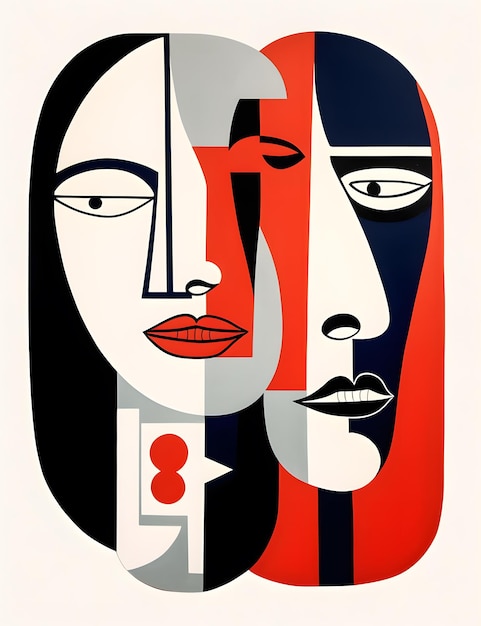Minimalism in art often invites a juxtaposition of simplicity and profound expression. The exploration of black and white drawings of faces serves not only as an aesthetic pursuit but also as a cultural commentary. This phenomenon invites discussions of emotion, identity, and perception through the lens of cultural relativism. By examining various styles and interpretations of minimalist face drawings, we can uncover deeper meanings and appreciate the richness of this artistic expression.
The essence of minimalist art lies in its ability to convey complex ideas through pared-down forms. Black and white drawings exemplify this principle, stripping away the superfluous to reveal fundamental truths about human emotion and societal interaction. In examining these drawings, one can observe a spectrum of facial expressions that transcend cultural boundaries yet are deeply embedded within specific cultural contexts.
First, it is imperative to consider the historical context of face representation in art. Regional art movements, from Western modernism to Eastern philosophical influences, have sought to articulate the human condition through portraiture. In the modernist tradition, artists like Pablo Picasso and Henri Matisse experimented with form and abstraction, reshaping the viewer’s understanding of facial representations. They emphasized facial features as mere suggestions, playing with the emotional resonance of each stroke. The resulting black and white drawings encapsulate both the specificity of a moment and the universality of emotion.
Furthermore, the emotive potential of minimalist drawings is particularly pronounced through the use of monochromatic palettes. The absence of color enables viewers to focus intently on the lines and shapes, fostering an engaged reflection on the expressions being depicted. In this context, the interplay of light and shadow becomes paramount, as it adds dimension and depth. Shadows can evoke melancholy or contemplation, while stark contrasts might signify conflict or joy. Each piece, therefore, functions as a conduit for introspection, leading audiences to project their emotions onto the figures presented.
Beyond a mere exploration of aesthetic choice, the discussion of black and white face drawings also hinges on the notion of cultural relativism. This principle posits that beliefs and practices should be understood in their own cultural context rather than judged against external criteria. Consequently, the interpretation of minimalist faces can vary significantly across different societies. For instance, what may be perceived as a solemn expression in one culture could be understood as a sign of introspection or peacefulness in another. This cultural lens allows for a richer dialogue surrounding the emotions that minimalist representations elicit.
Additionally, stylistic variations in black and white face drawings serve as exemplars of cultural identity. In some Indigenous cultures, for instance, facial markings and specific patterns tell a story of lineage and belonging. Artists may utilize minimalistic lines to indicate these features. These drawings reflect the community’s collective emotion and shared experience while challenging the audience to connect with the narratives woven into the simplicity of each design.
The rise of digital art has also transformed the landscape of face representation. Artists harness technology to manipulate minimalism in new ways, tapping into the global digital village. While this shift opens avenues for creativity, it also necessitates an examination of how cultural perceptions of minimalism adapt in the digital realm. The juxtaposition of traditional techniques against contemporary methods prompts questions about authenticity and the evolution of cultural expression. Digital black and white drawings can simultaneously pay homage to historical roots while paving new pathways for emotional connection.
Moreover, black and white face drawings resonate within contemporary discussions of mental health and emotional expression. In recent years, society has increasingly recognized the significance of mental health discourse. Artists, in capturing raw emotions through minimalistic facial depictions, manifest a powerful critique of societal expectations surrounding emotional expression. The simplicity of the lines often belies complex undercurrents, evoking a sense of vulnerability and candidness. Here, one can see an intersection of art, psychology, and cultural commentary that speaks volumes. These drawings encourage viewers to confront their own emotions and the societal norms that dictate their expression.
The thematic versatility of black and white drawings facilitates unique pedagogical opportunities. Educators can leverage these artworks in classrooms to discuss cultural relativity, artistic evolution, and emotional literacy. For instance, students could analyze how minimalist drawings represent a spectrum of emotions across diverse cultures. This exploration fosters a broader understanding of different cultures and perspectives, encouraging empathy and open-mindedness among peers. It serves as a conduit for dialogue, bridging gaps in understanding within multicultural contexts.
The continued popularity of minimalism in art signifies a collective yearning for clarity amidst chaos. The black and white drawing of faces embodies this quest, offering a mirror to diverse cultural experiences and emotional realities. By marrying minimalism with profound emotional expressions, artists have created an expansive dialogue around identity and perception grounded in cultural relativism. The intersection of these elements not only enriches our understanding of art but also enhances our appreciation of the myriad ways in which human experiences are articulated across the globe.
In summation, the exploration of black and white drawings of faces through the prism of minimalism and cultural relativism reveals intricate layers of meaning. This artistic form invites viewers into a contemplative space where emotion, identity, and culture coalesce. It challenges the observer not only to appreciate simplicity but also to reflect on the deeper implications of what it means to express the human condition within a diverse world.
